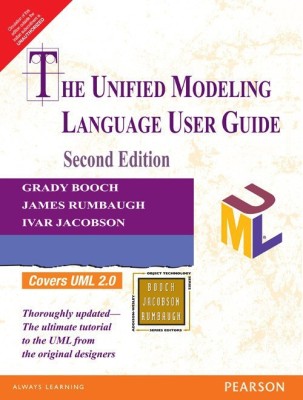The Unified Modeling Language User Guide(English, Paperback, Booch Grady)
Quick Overview
Product Price Comparison
The Unified Modeling Language User Guide introduces readers to the Unified Modeling Language, or UML, and also teaches them how to apply and use UML effectively. Summary Of The Book A graphical language, UML has been the standard for visualizing, documenting, constructing and specifying the artifacts of a software intensive system for the last 10 years. Written by the original developers of UML, The Unified Modeling Language User Guide is extremely useful for architects, developers, analysts, quality assurance professionals, project managers, program managers, and end users. The book is meant for new users, as well as experienced users looking for solutions to common modeling problems. The book is divided into 7 parts and has 32 chapters. The first part, Getting Started, introduces readers to Modeling and UML. It contains the chapters Why We Model, Introducing The UML, and Hello World! The second part is Basic Structural Modeling. The chapters in this part are Relationships, Classes, Class Diagrams, Diagrams, and Common Mechanisms. The third part, Advanced Structural Modeling, features chapters like Advanced Relationships, Advanced Classes, Packages, Interfaces, Types And Roles, Object Diagrams, Instances, and Components. Basic Behavioral Modeling, the fourth part, has 5 chapters. These are Interaction, Use Case Diagrams, Use Cases, Activity Diagrams and Interaction Diagrams. The fifth part, Advanced Behavioral Modeling, has the chapters Events And Signals, Processes and Threads, State Machines, State Diagrams, and Time and Space. The sixth part is Architectural Modeling, and contains chapters titled Artifacts, Collaborations, Deployment, Artifact Diagrams, Deployment Diagrams, Patterns And Frameworks, and Systems And Models. The seventh part has one chapter titled Applying the UML. About The Authors Grady Booch (February 1955) did his MasterŌĆÖs in Electrical Engineering from the University of California, Santa Barbara. His other books include Object Oriented Analysis and Design, The Unified Modeling Language Reference Manual, The Unified Software Development Process, Software Engineering with ADA, and Best of Booch: Designing Strategies for Object Technology. He is known in the world of software for his pioneering work and contributions to the field of Object Methods and Applications. Booch is currently the Chief Scientist, Software Engineering at IBM. Born in Sweden, Ivar Jacobson did his MasterŌĆÖs in Electrical Engineering from the Chalmers Institute of Technology, and completed his Ph.D. from the Royal Institute of Technology, Stockholm. Jacobson has also written The Object Advantage, Object Oriented Software Engineering, and The Essence of Software Engineering: Applying the Semat Kernel. Jacobson worked with Ericsson till he started his own company, Objective Systems, which was later merged with Ericsson, and then with Rational Software. In 2003, Rational was bought by IBM. Jacobson worked with IBM till 2004, and then quit to start Ivar Jacobson International. Born in Bethlehem, Pennsylvania, James Rumbaugh did his BS in Physics from Massachusetts Institute of Technology (MIT). He completed his MasterŌĆÖs in Astronomy from Caltech, California, and his Ph.D. in Computer Science from MIT. He has also written Object-Oriented Modeling and Design and OMT Insights: Perspective on Modeling from the Journal of Object-Oriented Programming. Rumbaugh worked for General Electric Research and Development Center, New York, for 25 years. In 1994, he joined Rational, and worked with Booch and Jacobson. After the merger of Rational Software with IBM in 2003, he moved to IBM, and retired in 2006.


